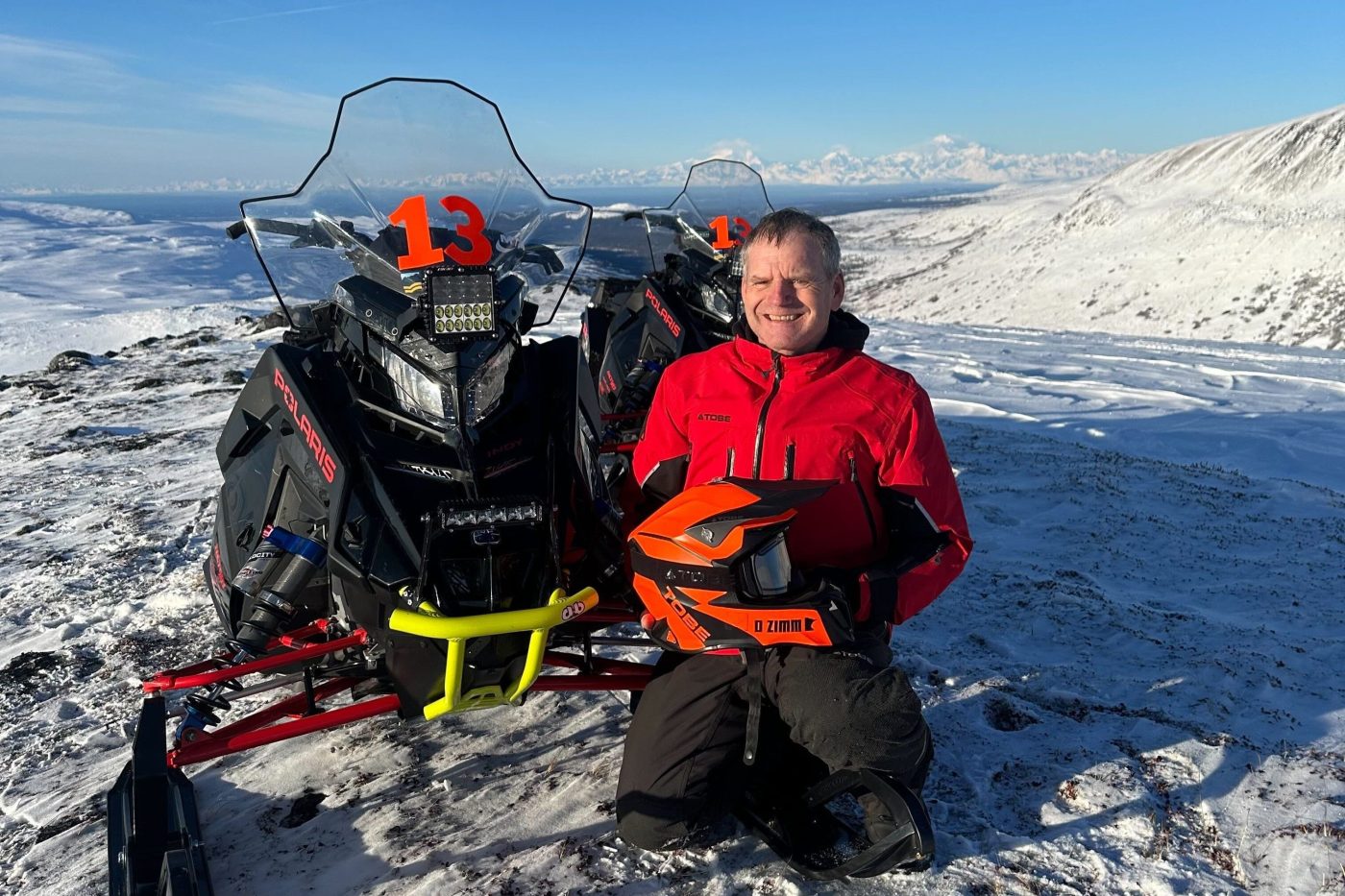
Taking on the world’s toughest snowmobile race
A 2,500-mile, seven-day race across Alaska is dubbed “The World’s Longest, Toughest Snowmobile Race” — the Iron Dog.
And Nisswa native Dan Zimmerman can call himself an experienced Iron Dogger of sorts — he’s competed in the race since 2022.
The Iron Dog race is a 2,503-mile team event, in the pro-class, and consists of two people on a team who go through 23 checkpoints along the route, said Mike Vasser, executive director of the Iron Dog race. There’s a halfway layover/wrench day in Nome, Alaska, for all the teams to evaluate their equipment, and then they leave from there and return to the starting area in Big Lake, Alaska.
“This is definitely the Super Bowl of snow machine racing,” Vasser said.
The 2025 Iron Dog took place Feb. 15-22. The cross-country race takes participants down rivers, over mountain ranges and through valleys with the winning team usually traversing the race in about 55 hours of riding time.
Snowmobiling through the mountains of Colorado in 2019 was the first time Zimmerman had heard of the Iron Dog race. And once he heard about it, there was no looking back.
Racing is not new to Zimmerman, it’s in his blood. His dad owned a John Deere dealership in Nisswa in the early ‘70s, and when John Deere sold out to Polaris, it became a Polaris dealership.
“My dad was a John Deere dealer for 40 years in Nisswa, and he became part of Team Green race program with John Deere in the mid-’70s. So I grew up around it. At that time, I was 10-11, years old. I went and watched my dad race the I-500 himself from Winnipeg to St. Paul — a product of our environment,” Zimmerman said as he pointed to a wall filled with trophies won by him, his dad and sister.
A wall of trophies at Dan Zimmerman’s home. (Tim Speier / Brainerd Dispatch)
Zimmerman said his dad first put him on a snowmobile around the age of 5, pointing out it was a John Deere.
Watching his dad race, Zimmerman said when he was 16 he was more than disappointed as they discontinued the I-500 in the 1980s, two years before he was able to sign up to race professionally on his John Deere.
A few years after they switched over to Polaris, they brought back the I-500 and Zimmerman said he immediately signed up. He raced in the I-500 from 1987 to ’91.
“It’s just been racing in my blood ever since,” Zimmerman said. “I did take a hiatus in ‘95 with my kids and whatnot. I let my kids grow up and just concentrated on business. However, I always snowmobiled, just not always competitively.”
That all changed with an abysmal snow season around 2019, sending Zimmerman to Colorado to enjoy his sport. Finding a guide to take them through the backcountry around Steamboat Springs, Colo., Zimmerman said they struck up conversation on racing during the trip and that is when he learned of Alaska’s Iron Dog race.
Zimmerman said it took him a few years of planning, finding a partner, setting up finances and obtaining sponsors before he entered his first Iron Dog in 2022.
“Just to get there is a feat in itself; it takes at least a year of preparation,” Zimmerman said. “Even though I’ve got four years under my belt, I always find something to improve upon. … It’s the relationships with the Alaskans that’s really driving me to go back. They’re so sincere and they’re so into Iron Dog. When you show up, you’re the Tom Brady. You’re an Iron Dogger, and just like the sled dogs, they want this thing to succeed. It’s the Alaska experience, the adventure. It’s beyond belief and unless you’ve experienced it. You have no idea.”
The Iron Dog is not for the faint of heart, with an attrition rate most years of around half the field not completing the race.
To those familiar with the race and its difficulties, a finish in the Iron Dog is a win and to win the Iron Dog is to be a champion.
Racers pose at the halfway point of the 2025 Iron Dog race in Nome, Alaska. (Contributed / Dan Zimmerman)
During the race, there are refueling checkpoints in villages along the race route about every 70 to 100 miles, with a mandatory reset at the halfway point in Nome. Each team is given 40 hours of layover time to go north and 40 hours to go south; those hours do not count against the team’s run time.
A team determines how they will utilize that time to either fix their machines, eat, sleep or prepare for the rest of the journey.
“It’s a lot of prep work,” Zimmerman said. “It’s a full year of preparation in order to get there.”
From working with snowmobile sponsors, clothing suppliers and coordinating with villagers, there is a lot of work that takes place in order to just get to the race, he said.
Zimmerman said that at almost all the checkpoints, there would be locals cheering on the participants and helping in any way possible. In preparation, he and his partner would practice different legs of the race and would drop off supplies and changes of clothes with different villagers.
“Alaska has a professional sport and it’s snowmobiling and the Iron Dog is the toughest, longest race in the world,” Zimmerman said. “The villagers come out. They have banners. They welcome you. They have their favorites, just like anything professional, and if you get into trouble, they’re more than willing to sacrifice parts off of their own machine to keep you running, skis, shocks, windshields, handlebars, mufflers, they’ll go and cannibalize their equipment so that you can keep going. They’re that dedicated to the race — It’s their Super Bowl.”
Each team has to be its own mechanic, he said. There is nowhere to pull over and have someone come to the machine; where it breaks down is where it is fixed, Zimmerman said. He talked about how they fit spare parts wherever they can find extra room in their machines.
One particularly tough part of the race is called the “burn” which refers to a 60- to 70-mile section of snowless terrain, which poses significant difficulties for racers as it rarely ever has snow cover. It is referred to as an inland desert.
Zimmerman said they were able to ride for about 15 to 20 minutes before they would have to stop and let their machines cool down.
“Alaskans refer to it as the ‘burn,’” Vasser said. “There was a fire there a long time ago and wiped everything out. Generally, every year there’s no snow in the ‘burn,’ which is typical. This year, we had 70 miles of no snow in that area. Back in 2014 and 2015 when I participated in the race, we rode about 125 miles of dirt.”
Each year, around half the teams that enter do not finish the race, most due to mechanical failures or injuries.
That, unfortunately, is what took Zimmerman out of the 2025 race.
On the first day of the race, Zimmerman and his teammate Bob Streiff, of Trego, Wis., were making their way through the Rainy Pass when they came across another team stuck in the deep snow.
“Rainy Pass is a high elevation, deep snow, single track trail, and they were stuck in the track,” Zimmerman said. “We were working the machine, trying to get it out, packing snow underneath the track, and trying to lift it out of the deep rut that it was in. It was trenched pretty bad.”
Zimmerman said it took all four of them to get the machine unstuck. And as they were getting it out, the track threw up a bunch of snow, hitting him in the face and scratching his eye.
Now, with a severe scratch to his eye, he said they had to continue on with the race for another full day before they were able to make it to a scheduled stop in McGrath, 339 miles from the start of the race. It was the first village that had a physician.
“They just said, ‘You’re done,’” Zimmerman said. “Yeah, they made me drop out on a medical because of the intensity of the scratch. So I had to wear a patch for a week, you know, the week of the race. It was a good race up until then.”
Dan Zimmerman talks about racing in the Iron Dog in Alaska on March 11, 2025. (Tim Speier / Brainerd Dispatch)
Having to drop out of the race, Zimmerman said he was a little disappointed, but that is just part of racing. No one knows what’s going to happen; that’s why they race.
Zimmerman said he and all the other teams are already working on getting everything ready for 2026, working with the manufacturers to procure a machine — actually four machines, as he uses two of them for practice and two of them for the race.
“I only wish I would have done it 20 years ago. Seriously, I’d be doing it every year. I would race this damn thing every year if I could, and I keep doing it,” Zimmerman said.
Zimmerman said if teams are interested, he would recommend they try the expedition class, even if they have a racing background. It’s not a normal kind of race, he said, it’s more of a multi-day marathon.
The expedition class is a half race, ending in Nome, where the pro class does their turnaround.
He said he would recommend teams looking to join to start getting a hold of somebody who has run in the Iron Dog previously and just start asking questions.
Related Articles
How to enjoy the natural and urban gems of the Pacific Northwest — even when your time is limited
William O’Brien State Park to unveil $5M in accessibility improvements
Millions tune in for 24-hour live coverage of Sweden’s epic moose migration
Skywatch: The two brightest stars, and a guest star
Open house set for proposed Maplewood-Woodbury-Afton trail
“You’ve got to be committed, you’ve got to stay focused,” he said, “and it’s so rewarding to ride across Alaska and not see a car, not see a road, a fence line, a power line, until you get to the villages.”
“These are the greatest athletes in the world because they have to endure so many different elements during the race that most normal professional athletes don’t deal with,” Vasser said. “They deal with a mental capacity, a physical capacity, a mechanical capacity, a cold-weather capacity, the ability to navigate with GPS. And the list goes on and on. And to do that in some conditions that are, you know, either 40 or 50 below, and you’ve got blowing wind, snowstorms, ground blizzards, and to complete the race in the times that these teams do is pretty incredible.”
With a $275,000 purse for the 2025 race, Vasser said the race grows each year, though they hope to attract more teams from the lower 48.
Zimmerman said he usually signs up for the race at the Iron Dog booth at Hay Days Grass Drags in North Branch, Minn. More information on the Iron Dog race is available at irondog.org.


